SM-62 Snark
The Northrop SM-62 Snark was an early-model intercontinental range ground-launched cruise missile that could carry a W39 thermonuclear warhead. The Snark was deployed by the United States Air Force's Strategic Air Command from 1958 through 1961. It represented an important step in weapons technology during the Cold War.[1] The Snark took its name from the author Lewis Carroll's character the "snark".[2]
| Northrop SM-62 Snark | |
|---|---|
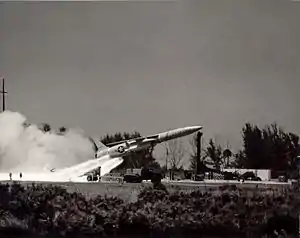 | |
| Type | Surface-to-surface cruise missile |
| Place of origin | United States |
| Service history | |
| In service | 1959–61 |
| Used by | United States Air Force |
| Production history | |
| Manufacturer | Northrop Corporation |
| Produced | 1958–61 |
| Specifications | |
| Mass | 21,840 kilograms (48,150 lb) without boosters; 27,000 kilograms (60,000 lb) with boosters |
| Length | 20.47 metres (67 ft 2 in) |
| Warhead | W39 thermonuclear warhead (explosive yield: 3.8 megatons) |
| Engine | one Pratt & Whitney J57 jet engine; and two Aerojet solid-propellant rocket boosters J57 turbojet: 47,000 newtons (10,500 lbf) of thrust; booster rockets: 580,000 newtons (130,000 lbf) of thrust |
| Wingspan | 12.88 metres (42 ft 3 in) |
Operational range | 10,200 kilometres; 6,300 miles (5,500 nmi) |
| Flight ceiling | 15,320 metres (50,250 ft) |
| Maximum speed | 1,046 km/hour |
Guidance system | astro-inertial guidance with CEP of about 2,400 metres (8,000 ft). |
Launch platform | mobile launcher |
The Snark missile was developed to present a nuclear deterrent to the Soviet Union and other potential enemies at a time when Intercontinental ballistic missiles (ICBMs) were still in development. The Snark was the only surface-to-surface cruise missile with such a long range that was ever deployed by the U.S. Air Force. Following the deployment of ICBMs, the Snark was rendered obsolete, and it was removed from deployment in 1961.
Design and development
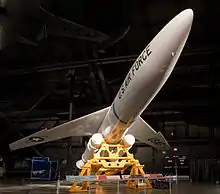
Work on the project began in 1946. Initially there were two missiles designed—a subsonic design (the MX775A Snark) and a supersonic design (the MX775B Boojum).(From the same poem: "The snark was a boojum, you see".[3]) Budget reductions threatened the project in its first year, but the intervention of Air Force General Carl Spaatz and the industrialist Jack Northrop saved the project. Despite this, its funding by Congress was low, and this program was dogged by changes in specifications. The earliest planned due date in 1953 passed with the design still in development, and the Strategic Air Command was gradually becoming less supportive of it. In 1955, President Dwight D. Eisenhower ordered that top priority be assigned to ICBMs and their associated guided missile programs.
Despite considerable difficulties with the development of the Snark, and reservations from the Department of Defense towards it, the engineering work continued.[4]
In 1957, tests of the Snark showed an estimated circular error probable (CEP) of 31 kilometres; 20 miles (17 nmi). By 1958, the celestial navigation system used by the Snark allowed its most accurate test, which appeared to fall 7.4 kilometres (4 nmi) short of the target. However, this apparent failure was at least partially caused by the British navigation charts used to determine the position of Ascension Island being based on position determinations less accurate than those used by the Snark. The missile landed where Ascension Island would be found if more accurate navigation methods had been used when developing the chart.[5] However, even with the decreased CEP, the design was notoriously unreliable, with the majority of tests suffering mechanical failure thousands of miles before reaching the target. Other factors, such as the reduction in operating altitude from 46,000 to 17,000 metres (150,000 to 55,000 ft), and the inability of the Snark to detect countermeasures and perform evasive maneuvers also made it a questionable strategic deterrent.
Technical description
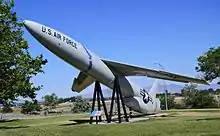
The jet propelled 20.5 meter-long Snark missile had a top speed of about 1,050 kilometres per hour (650 mph) and a maximum range of about 10,200 kilometres (5,500 nmi). Its complicated celestial navigation system gave it a claimed CEP of about 2,400 metres (8,000 ft).
The Snark was an air-breathing missile, intended to be launched from a truck-mounted platform by two solid-fueled rocket booster engines. The Snark next switched to an internal turbojet engine for the rest of its flight. The engine was a Pratt and Whitney J57, which was the first jet engine featuring a thrust of 44,000 N (10,000 lbf) or more. Since the Snark lacked a horizontal tail surface, it used elevons as its primary flight control surfaces, and it flew with an unusual nose-high angle during level flight. During the final phase of its flight, its nuclear warhead would have separated from its fuselage and then followed a ballistic trajectory towards its target. Due to the abrupt shift in its center of gravity caused by separation, the fuselage would have performed an abrupt pitch-up maneuver in order to avoid a collision with the warhead.
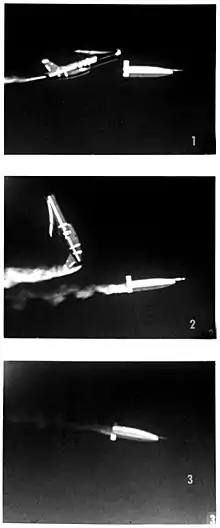
One unusual capability of the Snark missile was its ability to fly away from its launch point for up to 11 hours, and then return for a landing. If its warhead did not detach from its body, then the Snark could be flown repeatedly. Lacking any landing gear, it would have been necessary for the Snark to skid to a stop on a flat, level surface. A runway at the Cape Canaveral Space Force Station is still known as the "Skid Strip".
Operational history
In May 1957, a Detachment of Air Force instructors was formed at Amarillo Air Force Base , Texas as the first cadre of Air Force personnel supporting an Intercontinental missile system. None of the detachment members had any previous training or experience in missile maintenance. They were trained at the Northrop factory in California and then returned to Amarillo to establish the training school for the Snark maintenance personnel.
In January 1958, the Strategic Air Command began accepting delivery of Snark missiles at Patrick Air Force Base for training, and in 1959, the 702d Strategic Missile Wing was formed.
On 27 May 1959, Presque Isle Air Force Base, Maine, the only Snark missile base, received its first missile. Ten months later, on 18 March 1960, a Snark missile went on alert status. A total of 30 Snarks are known to have been deployed.[6]
The 702nd Wing was not declared to be fully operational until February 1961. In March 1961, President John F. Kennedy declared the Snark to be "obsolete and of marginal military value", and on 25 June 1961, the 702nd Wing was inactivated.[7]
Many in the U.S. Military were surprised the Snark, due to its dubious guidance system, was ever operational. In flight tests many were lost. A missile launched from Cape Canaveral in 1956 that was supposed to fly to Puerto Rico and back flew so far off course that it was last seen on radar off the coast of Venezuela. The wayward Snark missile was found somewhere in North-Eastern Brazil,[8] in 1983.[9][10] Many of those connected with the program commented in jest "That the Caribbean was full of 'Snark infested waters'."[11]
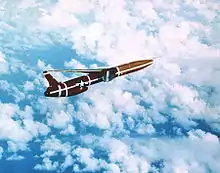
Survivors
Five Snark missiles survive in museum collections. They are located as follows:
- Air Force Space & Missile Museum at Cape Canaveral Space Force Station at Cape Canaveral, Florida.[12]
- National Museum of the United States Air Force at Wright-Patterson Air Force Base in Dayton, Ohio.[13]
- Strategic Air Command & Aerospace Museum in Ashland, Nebraska near Omaha.[14]
- Hill Aerospace Museum at Hill Air Force Base in Ogden, Utah.[15]
- National Museum of Nuclear Science & History near Kirtland Air Force Base in Albuquerque, New Mexico.[16]
See also
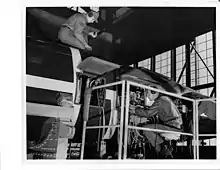
Aircraft of comparable role, configuration, and era
Related lists
References
Notes
- Northrop SM-62 Snark. National Museum of the United States Air Force. May 29, 2015.
- Carroll and Gardner 1982, p. 97.
- Carroll and Gardner 1982, pp. 14, 53.
- "Video: Arctic Sentinels. Building Rushed on Radar Defense, 1956/04/09." Universal Newsreel, 1956. Retrieved: 20 February 2012.
- Anderson, Fred (2016). Northrop: An Aeronautical History. Wipf and Stock Publishers. p. 132. ISBN 978-1-5326-0356-3.
- Gibson 1996, p. 151.
- "U.S. Air Force Fact Sheet: Development of the 45SW Eastern Rqnge." Archived 2012-02-06 at the Wayback Machine United States Air Force. Retrieved: 12 April 2012.
- "Snark ignores Air Force 'orders'." Pittsburgh Post-Gazette, 8 December 1956. Retrieved: 6 January 2013.
- "Long-lost missile found." The Leader-Post, 15 January 1983. Retrieved: 6 January 2013.
- "The Day They Lost the Snark" Air Force Magazine, December 2004. Retrieved: 17 August 2018.
- Zaloga 1993, p. 193.
- "Snark". Air Force Space & Missile Museum. Air Force Space and Missile Museum. Retrieved 4 October 2017.
- "Northrop SM-62 Snark". National Museum of the US Air Force. 29 May 2015. Retrieved 4 October 2017.
- "Missiles & Rockets". Strategic Air Command & Aerospace Museum. Strategic Air Command & Aerospace Museum. Retrieved 4 October 2017.
- "Northrop XSM-62A Snark". Hill Air Force Base. 16 October 2008. Retrieved 4 October 2017.
- "Heritage Park". The National Museum of Nuclear Science & History. The National Museum of Nuclear Science & History. Retrieved 4 October 2017.
Bibliography
- Carroll, Lewis and Martin Gardner. Lewis Carroll's The Hunting of the Snark: The Annotated Snark. London: William Kaufmann, 1982. ISBN 978-0-913232-36-1.
- Gibson, James N. Nuclear Weapons of the United States: An Illustrated History. Atglen, Pennsylvania: Schiffer Publishing Ltd., 1996. ISBN 0-7643-0063-6.
- Zaloga, Steven J. "Chapter 5." Target America: The Soviet Union and the Strategic Arms Race, 1945–1964. New York: Presidio Press, 1993. ISBN 0-89141-400-2.
External links
| Wikimedia Commons has media related to Northrop SM-62. |
- The Evolution of the Cruise Missile by Kenneth P. Werrell
- The Day They Lost The Snark by J.P. Anderson, Air Force Magazine article about a Snark that was test-fired and rumored to have been found in Brazil
- Excellent article on the Snark on FAS.org
- "Our First Guided Missileaires", Popular Mechanics, July 1954, detailed article on Snark and the USAF school to train personnel for it